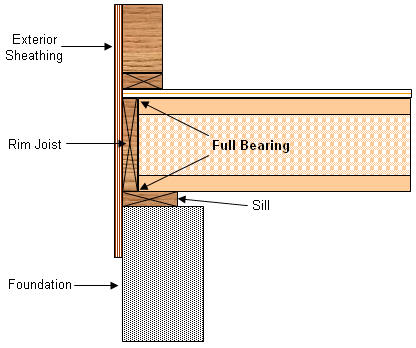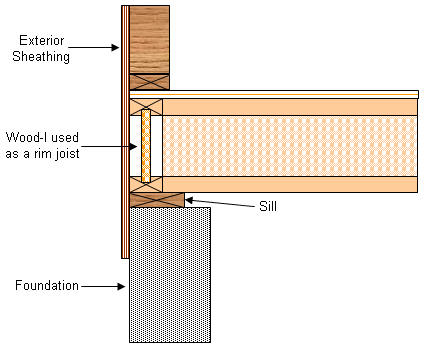Problem: Inadequate Support - Wood-I joists are overstressed around perimeter
Cause:
Wood I joists have limited capacity to transfer roof and floor loads vertically from above.
Solutions:
Ensure properly sized rim joists with full bearings.
Wood I joists are relatively new and many builders and home handymen just use them in place of the older style dimensional lumber joists. Wood I joists require different framing techniques than dimensional lumber joists.
- Rim joists can be used to transfer vertical loads from above, through the floor system and down to the support below. Rim boards have varying requirements, depending on the loading conditions. The manufacturer's design must be followed as shown in Figure 7.

Figure 7 - Adequate Rim Board With Proper Bearing
- The rim boards used for the main floor of a two-storey house must be thicker than the rim boards used for the second floor of the same two-storey house.
- Rim boards must be installed so that they have full bearing at the top and bottom. If full bearing contact is not achieved, the rim board cannot transfer the required loads.
- Wood I floor joists that are subject to excessive loads, because of faulty rim board installation can twist or crush, resulting in serious structural failure of the flooring system.
Install wood I rim joists or blocking panels.
- Rim joists or blocking panels can be used instead of rim boards. Rim joists are wood-I joists that run around the perimeter of the floor system to transfer the vertical loads from above. Sawn lumber is not used, as it will shrink and transfer loads to the floor joists. Care must be taken when using wood I joists as rim joists to ensure that the floor joists have adequate bearing on the wall or sill plate. Check the manufacturer's requirements for minimum bearing lengths as shown in Figure 8.
- Joints in underlay panels must be offset more than 8″ (200 mm) from joints in subfloor panels.

Figure 8 - Wood I Joist/Blocking Panel Used For Perimeter Support
- Blocking panels are short sections of the wood I floor joist that fit between the floor joists. These short sections transfer the vertical loads through the floor system in the same manner as rim joists.
- When rim joists or blocking panels are used, closure panels must be installed around the perimeter. These are simply strips of wall sheathing that enclose the floor system and provide support for the exterior finish.
- Ensure wood I floor joists have sufficient room for end bearing. If blocking panels are used, floor joists can extend to the outside of the foundation or bearing wall.
